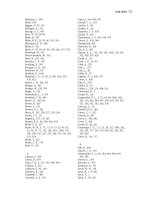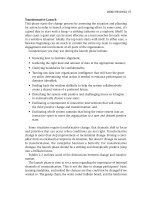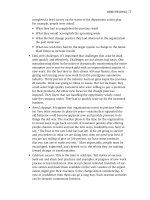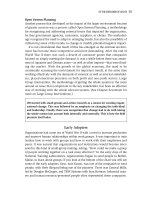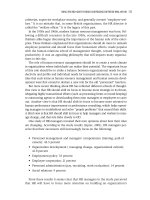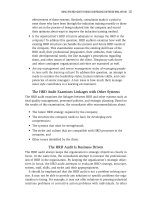Practicing Organization Development (A guide for Consultants) - Part 31 pdf
Bạn đang xem bản rút gọn của tài liệu. Xem và tải ngay bản đầy đủ của tài liệu tại đây (284.05 KB, 10 trang )
CHAPTER TEN
Launch
Assessment and Action Planning
D.D. Warrick
F
ew processes are more intriguing in OD than assessment and action plan-
ning, and few processes can stimulate and result in more change. In this
important phase of OD that we are calling “Launch,” valuable information
is gathered and analyzed, and a collaborative approach is used to evaluate the
information and plan actions that provide a sound strategy for making organi-
zations, groups, or individuals successful. Assessment and action planning are
among an OD practitioner’s most important skills and are also among the most
unique, interesting, and value-added aspects of OD. Consider, for example:
• The energy and hope that is generated when organizations are actually
interested in what employees have to say;
• The potential disasters that are avoided when an organization or team
has a clear sense of reality about what is really going on versus having
an illusion of doing well while the organization is regressing;
• The value of an assessment that provides important information that
results in a merger, inter-organization effort, or cross-cultural project
being successful;
• The elation and value that come from discovering through an assess-
ment that efforts to change and transform an organization are working
and from learning why they are working; and
271
∂
∂
16_962384 ch10.qxd 2/3/05 12:17 AM Page 271
• The satisfaction that comes from possibly saving a career by providing
multi-rater feedback to a leader who is floundering and now sees
options that might help identify what is needed to succeed.
These are only a few of the many ways that Launch can have a significant
impact on the success of organizations, teams, and individuals. However, as
with any high-payoff effort, risks are involved as well. What if the assessment is
poorly designed and produces misleading, confusing, inaccurate, or inflamma-
tory results? What if the data are ignored or used for harmful rather than help-
ful purposes? What if the real issues are dismissed or explained away and the
whole OD process becomes suspect? What if the action planning process
becomes so complex and time-consuming that people lose interest and little is
accomplished?
Thus, we have a high payoff and very interesting and engaging process that,
if not skillfully done, can result in more harm than good and that can make or
break the OD process. This is why assessing organizations, groups, and indi-
viduals and guiding action planning that focuses on a sound strategy for suc-
cess requires a considerable amount of skill. It is a necessity for OD practitioners
to become proficient in these important aspects of OD. This chapter is designed
therefore to provide the fundamentals of assessment and action planning—
combined into the single phase called launch—so that a high degree of success
can be expected in this phase of the OD change process.
THE PURPOSE OF THE LAUNCH PHASE
While assessment and action planning may be used informally in the Pre-Launch
phase of OD and more formally in the Launch phase, they are, in fact, used in
various ways throughout OD efforts. The purpose of the launch phase is
1. To discover a broader perception of reality (as reality can never be
completely known) and, based on that perception of reality, to develop
action plans that include sound strategies for helping organizations,
groups, and/or individuals succeed. Knowing how reality is perceived
by various individuals makes it possible to change and improve almost
anything or at least to know that change and improvement are not
needed or are not likely to succeed or to be possible. Without knowing
how reality is perceived, issues that must be addressed and changes
that must be made may be overlooked, wrong assumptions and poor
decisions made, considerable time and resources invested in treating
symptoms rather than root real causes, and cures attempted that are
worse than the diseases. It has been said that a fool is a person who
272 PRACTICING ORGANIZATION DEVELOPMENT, 2ND EDITION
16_962384 ch10.qxd 2/3/05 12:17 AM Page 272
continues the same behaviors while expecting a different result. This is
often the case in organizations because of a lack of good assessment
and action planning.
2. To understand the strengths (major assets and what is working) and
opportunities for improvement (what is not working or could be
improved) of organizations, groups, and individuals and what it will
take for each to succeed.
3. To collect relevant information for use in designing, managing, and
monitoring the change process and improvement efforts. Monitoring
progress is especially an important and often overlooked assessment
function, as corrections can be made if it is known that the desired
progress is not being made.
4. To gather valuable information that will be helpful in developing new
organizations and groups.
5. To give the appropriate people an opportunity to be involved in offer-
ing their perceptions of reality and planning change.
6. To motivate change in a number of ways:
• By creating hope and expectations that improvements will be made
and that what is working will be acknowledged and maintained;
• By allowing people to share observations, opinions, feelings, and
ideas that may have been overlooked or ignored;
• By seeding the organization for change, assessment and action plan-
ning involve people in the change process, start them thinking
about present realities and future possibilities, make it possible to
build confidence and trust in the change process, and often moti-
vate change when ideas are stimulated by completing a survey or
participating in an interview;
• By providing a strong incentive for change if assessments are used
before, during, and/or after change since the results will show if
improvements have been made.
7. To evaluate the success of OD efforts and plan future actions before,
during, and after assessments to provide excellent information for eval-
uating the results of OD efforts. This purpose, of course, favors well-
planned and executed OD efforts and exposes those that are not. It
should be pointed out that other variables may affect the results and
may need to be taken into account in interpreting the results. While
post-OD assessments can provide important information for evaluating
and learning from OD efforts, they also provide valuable information
for planning future actions.
LAUNCH 273
16_962384 ch10.qxd 2/3/05 12:17 AM Page 273
A MODEL FOR ASSESSING ORGANIZATIONS
AND PLANNING ACTIONS
A model for assessing organizations and planning actions is presented in Exhibit
10.1 and discussed in more detail later in this chapter. The model can be used for
working with whole organizations, groups, or individuals and is intended to pro-
vide guidelines rather than rigid steps. The potential impact of this critical part of
the OD process is often under-realized because of a lack of understanding of how
to plan and guide assessment and action planning activities effectively.
In applying the model, several considerations should be kept in mind:
1. The potential uses of the assessment and action planning processes
go far beyond traditional OD literature, and many of these uses may
require considerable innovative thinking in how to approach them. For
example, while much of the OD literature deals primarily with existing
organizations and groups, the processes may be used in forming new
organizations, groups, and alliances; in preparing for and integrating
merged organizations; and in working on social, political, or interna-
tional issues or with geographically dispersed or culturally diverse
groups.
2. Technology has opened up many new alternatives for assessing organi-
zations, groups, and individuals and for guiding the action planning
process. Examples include electronic questionnaires, real-time messag-
ing, conferencing, and action planning without geographical con-
straints, and others.
3. In assessing organizations and doing action planning, there is always
the ideal and the reality with which to deal. Approaches and methods
may have to be modified to fit the realities, such as practical, resource,
political, or technological considerations. For example, it may be desir-
able both to survey and interview people, but the leaders are willing
only to allow interviewing. A skilled OD practitioner can usually work
within the boundaries given, but there may be times when the bound-
aries will not provide valid results, and the client must be told so.
Every possible effort should be made to make all phases of the OD process,
especially the assessment and action planning activities, as clear and simple as
possible, and to keep in mind the focus on improving both organization health
and effectiveness. In a recent survey of the top leaders in the field of OD (see
Chapter Six), the most popular OD definition is still Richard Beckhard’s (1969,
p. 9), which defines the purpose of OD as increasing organizational effective-
ness and health. OD efforts sometimes die of their own weight because they
have become too complex and time-consuming, and others lose sight of the
274 PRACTICING ORGANIZATION DEVELOPMENT, 2ND EDITION
16_962384 ch10.qxd 2/3/05 12:17 AM Page 274
LAUNCH 275
Exhibit 10.1. Organization Assessment and Action Planning Guidelines
Action Planning
Involve Key Stakeholders
1. Involve those who are in the best posi-
tion to understand and utilize the
assessment and lead needed changes.
2. Ensure that someone will lead the
change effort and, if needed, develop
a change team to plan and manage
the change process.
Evaluate and Prioritize Relevant Data
3. Develop a process for evaluating, priori-
tizing, and making the assessment
information manageable and useable.
4. Clarify the focus of change efforts (whole
organization, group or intergroup, indi-
vidual, structural, technological, etc.).
5. Consider the level of desired change
(fine-tuning, incremental, or transfor-
mational).
6. Focus on present realities and future
ideals and possibilities and explore alter-
natives for achieving greater success.
Agree on the Changes to Be Made
7. Agree on the actions to be taken, recog-
nizing that it is better to do a few things
well than many things poorly.
8. Evaluate the change from a systems per-
spective, considering the implications of
the changes and the alignment needed.
Develop a Change Strategy
9. Identify any forces working for or
against the desired change.
10. Explore strategy alternatives.
11. Develop a change process based on a
sound change model.
12. Develop a process for monitoring and
managing the change process.
Clarify Roles and Follow-Through
Responsibilities
13. Clarify the roles and follow-through
responsibilities of all involved in the
change process.
14. Commit to keeping the change process
as clear and simple as possible and to
improving both the health and effec-
tiveness of the organization.
Organization Assessment
Planning
1. Involve the right people in the project.
2. Clarify the desired goals and
outcomes of the assessment.
3. Agree on what and who will be
assessed.
4. Choose methods.
5. Determine how to best collect data.
6. Determine how to analyze and
report the data.
7. Determine how to feed back and
utilize the data.
8. Agree with leaders on the process
and how the results will be utilized
and coach the leaders on their role
in making the assessment successful.
9. Develop planning milestones.
Data Collection
10. Assure that anyone involved in
performing the assessment is properly
trained.
11. Prepare the organization for the
assessment.
12. Perform the assessment.
Data Analysis
13. Develop a strategy for analyzing
and presenting the assessment results
in a user friendly way.
14. Prepare a simple-to-understand and use
presentation of the findings.
Data Feedback
15. Design a feedback strategy for
determining who gets what
information how and when.
16. Prepare the appropriate people on
how to use the results for helpful
and not harmful purposes.
17. Decide on when and how to connect
the feedback to action planning.
18. Prepare people for how to understand
and utilize the data in helpful and posi-
tive ways to diffuse anxiety and ensure
that the process will be a beneficial and
useful one.
Practicing Organization Development, 2nd Ed Copyright © 2005 by John Wiley & Sons, Inc. Reproduced
by permission of Pfeiffer, an Imprint of Wiley. www.pfeiffer.com
16_962384 ch10.qxd 2/3/05 12:17 AM Page 275
importance of a health/effectiveness balance in OD strategies and in achieving
organization success.
DEVELOPING AN ASSESSMENT AND
ACTION PLANNING PHILOSOPHY
Significant and sometimes radical changes in the environment in which orga-
nizations must compete and changes in the field of OD itself make it important
to develop a sound philosophy for assessing organizations and planning actions.
Philosophies may run, for example, from a more deficit or problem-centered phi-
losophy (focusing on weaknesses and what is wrong and broken and how to fix
the problems) that characterized some of the early OD efforts, to a more positive
appreciative inquiry type of philosophy that focuses on stories of best practices
and experiences, discovering the life-giving properties present when organiza-
tions are performing optimally, to philosophies that incorporate both views. The
positive approach has many forms but is rapidly growing in publications and
research by appreciative inquiry proponents. The AI perspective is clearly artic-
ulated in Chapter Twenty-Two by David Cooperrider, one of the founders of the
appreciative inquiry approach.
While it would be difficult to find supporters for the deficit or problem-centered
approach to the exclusion of other approaches, a healthy and continuing debate
exists about whether a balanced approach that looks at both the positives and
negatives is most appropriate or if an appreciative inquiry type of approach
should become the exclusive approach of OD practitioners. Some OD practition-
ers are concerned about a one-size-fits-all strategy, and others have become very
strong advocates for the exclusive use of an appreciative inquiry approach. In
either case, every OD practitioner needs to become a student of these various
philosophies and to develop a sound and defensible assessment and action plan-
ning philosophy as it will significantly influence the approach used.
THE IMPORTANCE OF UNDERSTANDING
ORGANIZATIONS AND WHAT IT TAKES TO BUILD THEM
Underlying any effort to assess organizations and plan actions and strategies
that will lead to an organization’s success is an understanding of organizations
and what makes them successful. In other words, an OD practitioner must know
what to look for and what it will take to build a successful organization so that
action plans will be driven by the right kinds of information as well as sound
principles for building healthy, high-performance organizations capable of suc-
ceeding in today’s changing times.
276 PRACTICING ORGANIZATION DEVELOPMENT, 2ND EDITION
16_962384 ch10.qxd 2/3/05 12:17 AM Page 276
Understanding Organizations Before Trying to Change Them
Organizations are much like people. They have beliefs, values, attitudes, habits,
and strengths and weaknesses. Like people, they can be very different. Some
are exceptionally focused, healthy, productive, vital, innovative, quick to adapt
to change, willing to learn and grow, and great places to be. Others are confused,
unhealthy, dysfunctional, rigid, slow to learn and grow, resistant to change, and
great places to avoid. Some organizations live by simple and straightforward
principles and are easy to understand, and some are complex and difficult to
understand and are somewhat schizophrenic with multiple and conflicting
personalities. Also, like many people in today’s fast-moving and unpredictable
environment, organizations can go from champ to chump and success to fail-
ure in a short time if they don’t keep improving and adapting. All of this is said
to emphasize the importance of understanding organizations before trying to
change and improve them so that the strategies fit the unique characteristics,
needs, and circumstances of each organization. Otherwise, strategies are likely
to fail or underachieve what is possible.
In trying to understand organizations, it is helpful to have a model or frame-
work that can be used in knowing what to look for. Models can also be used in
designing an assessment strategy, developing interview questions and ques-
tionnaires, and in organizing and presenting information in a useful and under-
standable way. Several such models are described below:
1. The Diagnosing Organization Systems Model (Cummings & Worley,
2001, p. 88). This is perhaps the most comprehensive of the models for
understanding organizations. It is a systems model that looks at Inputs,
Design Components (often called Processes in other models), and Out-
puts at the Organization, Group, and Individual levels. Inputs consist
of the things that affect the operation and performance of organiza-
tions, groups, and individuals, such as the general environment, mar-
ket conditions, capital, technology, human talent, organization design,
and so forth. Design components describe the processes in organiza-
tions that affect the performance of organizations, groups, and individ-
uals. This is the area where OD practitioners focus much of their
attention. For example, at the organization level, the focus may be on
organization strategy, technology, structure, measurement systems,
human resource systems, and culture. At the group level, the focus
may be on task structure, goal clarity, team functioning, group norms,
and group composition. Cummings and Worley chose Hackman and
Oldham’s Job Characteristics Model (Hackman & Oldham, 1975, pp.
150–170) to describe individual processes, such as task identity (doing
a complete job), skill variety (job involves a variety of skills, talents,
and activities), autonomy (job provides substantial freedom and
LAUNCH 277
16_962384 ch10.qxd 2/3/05 12:17 AM Page 277
self-discretion), task significance (importance of the job), and feedback
about results (quality of feedback on performance).
2. The Six Box Model (Weisbord, 1978). Weisbord identified six organiza-
tional components that can be used to understand organizations. The
components are organizational (1) purposes, (2) structures, (3) rela-
tionships, (4) rewards, (5) leadership, and (6) helpful mechanisms.
These six components influence and are influenced by the environ-
ment in which the organization functions.
3. The Organization Dynamics Model (Kotter, 1976). Kotter’s model
focuses on seven major organizational components to understand orga-
nizations. These are (1) key organizational processes, (2) external
environment, (3) employees and other tangible assets, (4) formal orga-
nizational arrangements, (5) social systems, (6) technology, and (7)
dominant coalition (top management).
4. The Organization Health Model (Warrick). Most organization models use
similar criteria but may have different ways of describing, clustering,
and presenting the criteria. The Organization Health Model is a practical
model designed to help OD practitioners know what to look for in
understanding healthy and unhealthy characteristics in organizations.
Criteria for Building Healthy, High-Performance Organizations
Action plans backed by the knowledge of how to build healthy, high-performance
organizations capable of succeeding in today’s new organization are sure to have
a far greater impact than action plans simply designed to address issues identi-
fied in organization assessments. Many efforts have been made to study best-
run organizations and to identify what separates these organizations from the
rest. For example, it would be good to review the research of Ashkenas, Ulrich,
Jick, and Kerr, 1995; Collins, 2001; Collins and Porras, 1994; Freiberg and
Freiberg, 1996; Hamel and Prahalad, 1995; Pfeffer, 1994 and 1998; Slater, 2001;
and Fortune magazine’s annual list of America’s Most Admired Companies, The
Global Most Admired, and The 100 Best Companies to Work for.
While every organization is different, there are many consistent themes in
research and in experts’ views on successful organizations. For example, the
best typically perform far above the industry average and tend to focus on both
building a great organization and on getting great results, while the rest have a
plan for neither or become preoccupied with only one or the other, such as get-
ting great results, while neglecting the other areas. The principles that tend to
characterize the best often reflect common sense, which is not so common, and
a simplicity to doing things right, which is seldom practiced. However, while it
is very important for an OD practitioner to be familiar with the fundamental
278 PRACTICING ORGANIZATION DEVELOPMENT, 2ND EDITION
16_962384 ch10.qxd 2/3/05 12:17 AM Page 278
principles that tend to characterize successful organizations, it is also important
to realize that the application of these principles may differ from organization
to organization, that some organizations find unorthodox ways of succeeding,
and that unusual circumstances, such as rapid changes in economic or market
conditions, or significant events, such as the terrorist acts on the World Trade
Center, can derail or cause temporary setbacks to even the best.
Several models are presented to stimulate thinking about what organizations
need to do to be successful in these changing times. While these are simple
descriptive models, they contain a wealth of information about the fundamen-
tals of organization success.
1. Built-to-Last Model (Collins & Porras, 1994). The long-running best-
selling book Built to Last, by Collins and Porras, provides valuable
insights into what long-term top-performing companies, such as GE,
Hewlett-Packard, Johnson & Johnson, Marriott, Merck, Nordstrom,
and Wal-Mart have done to remain successful.
2. Good-to-Great Model (Collins, 2001). Another best selling book, Good to
Great, by Jim Collins is based on extensive research on eleven compa-
nies in a sample of 1,435 that were able to go from getting good results
to getting great results and were able to sustain those results for at
least fifteen years. The eleven companies attained exceptional results,
averaging cumulative stock returns 6.9 times the general market in the
fifteen years following their transition from good to great. Some of the
companies represented in the study were Circuit City, Fannie Mae,
Gillette, Pitney-Bowes, and Walgreens.
3. The Fundamentals of Building Successful Organizations Model
(Warrick). The principles shown in Exhibit 10.2 were compiled from
evaluating the literature on best-run organizations, asking over one
thousand executives and MBA students what it takes to build a suc-
cessful organization, and over thirty years of experience in working
with many types and sizes of organizations.
ASSESSING ORGANIZATIONS
Prepared with an understanding of the purpose of the assessment and action
planning process, a big-picture model of what the process could look like, a
sound philosophy to guide assessment and action planning decisions and meth-
ods, and ideas about how to understand organizations and build successful orga-
nizations, the OD practitioner is now ready to begin the assessment process. As
LAUNCH 279
16_962384 ch10.qxd 2/3/05 12:17 AM Page 279
280 PRACTICING ORGANIZATION DEVELOPMENT, 2ND EDITION
Exhibit 10.2. Fundamentals of Building Successful Organizations
1. Lead the Way
• Good leadership is the major key to success.
• Top-level leaders have a passion for excellence and are humble, competent,
visible, approachable, trustworthy, straightforward, and skilled at providing
vision, direction, and inspiration. They walk the talk.
• Top-level leaders are close to the organization and function like a united,
focused, results-oriented top leadership team.
2. Develop a Strategy for Succeeding and Get Everyone Using the Same Play Book
• The vision, mission, core values, and strategic goals are clear, energizing, and
known throughout the organization.
• The strategy includes a strong emphasis on both people and performance.
• Everyone knows how he or she can contribute and is empowered to do so.
3. Structure the Organization for Results
• The right people are in the right places doing the right things.
• Everything is aligned to support the goals and values.
• Simple, flat, non-bureaucratic, adaptable, responsive design that is effective,
efficient, and results oriented.
• Processes, systems, technology, and practices make it easy to get things done.
4. Build a High-Performance Culture
• Values-driven culture that encourages excellence and frees people to be their
best.
• Culture encourages teamwork and being self-directing.
• Culture values disciplined action and entrepreneurship.
• Culture encourages being open and straightforward, treating people with
respect, and doing what is right.
• High level of trust.
• Culture values innovative thinking.
5. Develop Value-Added Managers
• Managers at all levels are expected to add value, get results, and make things
happen.
• Managers are empowered to get the job done and are expected to do the
same with their people.
• A strong emphasis is placed on the continuous development of the leadership
and management skills of present and potential managers.
6. Take Care of Your People
• Having a committed, motivated, and well-trained workforce is a top priority of
the leaders.
• People at all levels are treated with value.
Practicing Organization Development, 2nd Ed Copyright © 2005 by John Wiley & Sons, Inc. Reproduced
by permission of Pfeiffer, an Imprint of Wiley. www.pfeiffer.com
16_962384 ch10.qxd 2/3/05 12:17 AM Page 280
